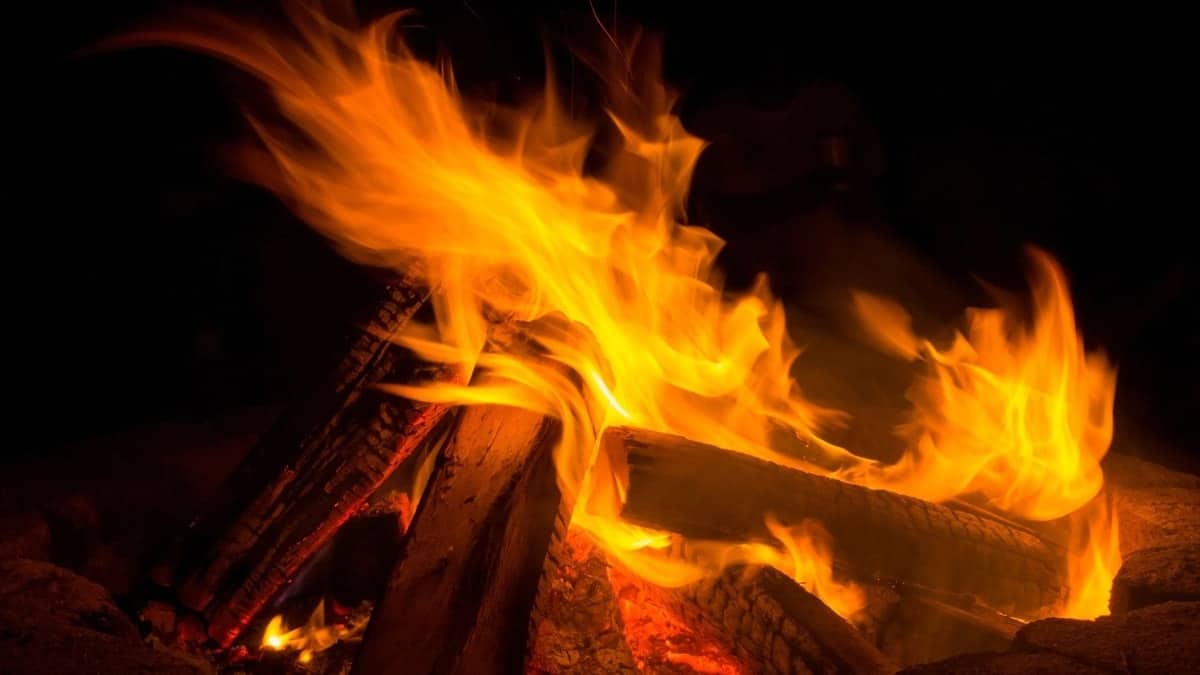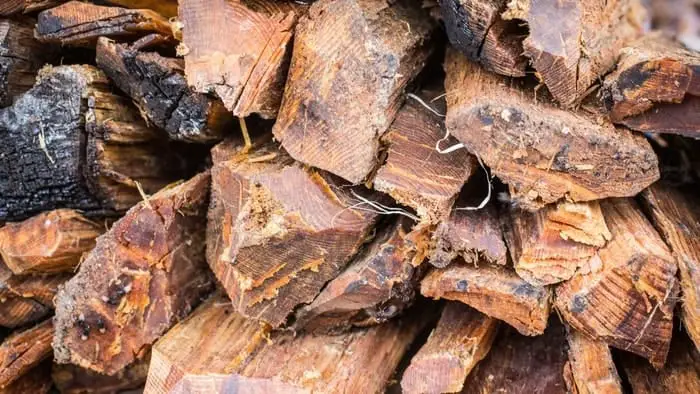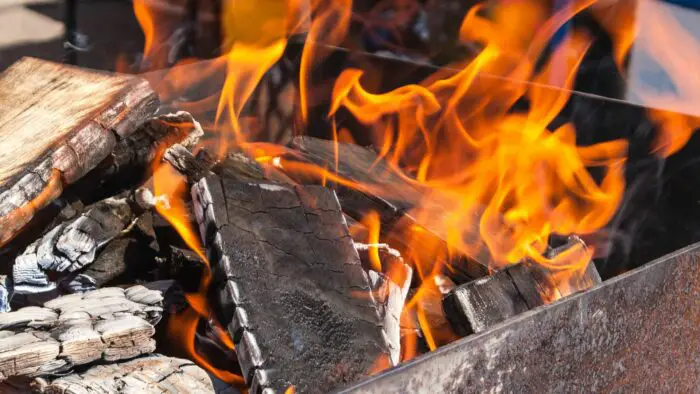Last Updated on March 2, 2023 by Griselda M.
This blog post is dedicated to the hottest burning wood that keeps for much longer. Do you use firewood to heat your home? Have you noticed what wood burns the hottest and what burns the worst?
All wood burns, but not all of them burn the same! Some burn hotter, while others are much slower. Additionally, some wood smokes a lot, while others have plenty of resin or sap that clogs the chimney fast.
The best type of firewood burns hot and steadily, producing heat and burning completely. These woods are from hardwoods like ash and hickory rather than softwoods like cedar and pine.
So What Makes Good Firewood?
What makes some types of firewood better at burning than others? Two factors make firewood different – water content and density. The drier and denser the firewood, the better it will burn and produce more heat.
Hardwood has good density and low levels of sap or pitch, making it better for firewood than softwood.
Read more about: Keeping Your Patio Warm In Winter Months
What Wood Burns the Hottest?
The hottest burning wood is Hardwood. Hardwoods like ash, birch, oak, maple, and most fruit trees are the best-burning woods that will give you the hottest and longest burn time. These woods have sap and pitch and are cleaner to handle than softwoods.
However, hardwoods are more expensive than softwood and more prone to leave clinkers – a hard, stony residue found in the leftover ash.
When burning birch wood, be aware of the phloem – a thick inner brow bark. Phloem retains a lot of moisture and can prevent the wood from drying evenly. It is, therefore, best to mix birch with another type of hardwood for a cleaner burn and less smoke.
Smoke leads to a buildup of creosote, a byproduct of wood combustion that consists of tar, common in causing chimney fires.
Examples of Wood that Burns Hottest
We cannot exhaust this list, but we will try to name a few that can guide you in searching for good wood.
Hardwoods include Birch, aspen, alder, ash, beech, cottonwood, oak, maple, hickory, fruit trees, mesquite, ironwood, elm, etc.
Softwoods include cedar, fir, pine, redwood, hemlock, larch, spruce, etc.
Comparing Wood by Its Heat Energy
Not all hardwoods and softwoods are created equally. Some burn far better than others, while others produce more heat. Below are some of the best firewood classified according to their heat value, which measures how much heat they produce when burning.
- The hottest burning wood offers heat energy that is equivalent to 200 to 250 gallons of fuel oil. These include ironwood, apple, American beech, shagbark hickory, mesquite, yellow birch, sugar maple, red oak, white oak, and white ash.
- This medium category offers heat energy equivalent to 150 to 200 gallons of fuel per cord of wood. They include Douglas fir, cherry (black), birch (white), American elm, red maple, silver maple, and Tamarack.
- The lowest category of heat energy produces about 100 to 150 gallons of fuel oil per cord of wood. They include cedar (red), alder (red), hemlock, aspen, white pine, lodgepole pine, cottonwood, redwood, Sitka spruce, and western red cedar.
Ensure Your Wood Burns Well
Make sure your wood is dry. Do not burn green or insufficiently dried wood. It produces less heat and more smoke – creosote than well-dried or seasoned wood.
Stack your wood properly under a shade that will protect them from rain or cold temperatures. Well-stacked wood has efficient air circulation, which is important to continue its drying process. Cover only the top of the stacked wood rather than the rest.
Be sure you are using thoroughly dried wood before burning. When burning, burn the older dryer wood first to avoid wood rot and waste.
Dry wood should have a moisture content of only 15 to 25% for burning. Moisture that is higher than 25% is not good for burning wood. Wood with this kind of moisture burns inefficiently and poorly, producing excessive water vapor and smoke.
Woods to Avoid
It is important to use only firewood that burns well and produces a good amount of heat, as we have seen above. However, you ought to avoid using certain wood because it will not give you a good amount of heat and will instead produce a lot of smoke.
Softwood
Softwood is the cheapest type of wood you can ever buy. On its own, it tends to burn faster and leave finer ash than hardwoods. Some softwoods can be messy to handle and produce more creosote buildup in your chimney.
Salvaged firewood or other scraps
These are known to save you a lot of money when you need to heat your home with wood. However, this type of wood should be avoided for safety and health reasons. Most of these produce hazardous fumes indoors, as well as chimney emissions that are an environmental concern. In addition, some pose additional risks to stove metals or create a hazardous buildup of creosote in your chimney that can cause fires.
For your safety, avoid burning the following.
- Painted or varnished trim, wood, or other wood by-products
- Driftwood
- Pressure-treated lumber
- Engineered sheet goods, particleboard, MDF, and plywood
- Compressed hardwood or other paper products
Some woods, like aromatic cedar, can accelerate the problem if you suffer from allergies, so use them with caution.
What is the Slowest Burning Wood?
I was recently asked what is the slowest burning wood in comparison to others. The answer is simple, as hardwood has proven time and again that it gives off the most intense fire while lasting much longer. You would also notice that when lit, hardwood turns into hot coals that give off heat for extended periods because of its slow-burning capabilities. In other words, you can expect to enjoy the warmth of a hardwood fire long after it has simmered down.
However, keep in mind that the hardwood endurance can be extended if it is properly seasoned and dense when lit up. The reason for this is because of how tightly packed it is, which tremendously slows down the burning process. Slow-burning hardwoods that you can opt for include ash, maple, oak, hickory, walnut, hawthorn, apple, Osage orange trees, and hornbeam.
But, from the lot, the one that is the slowest to season is oak. This particular wood needs a two-year timespan to become fully seasoned before use. It is also advisable to use slow-burning oak wood together with logs that burn quickly for extended warmth.
Hottest Burning Wood in North America
The hottest burning wood in North America is hardwood. This is because compared to softwoods, hardwoods burn much hotter and longer. But, do keep in mind that not all varieties of hardwood have the same endurance mechanisms and longevity. In other words, hardwoods that include elm and walnut have lower heat capabilities than hickory, oak, birch, and ash.
Oak is amongst the best firewood from the lot because of its slow-burning properties that last through the night. North American residents have access to an abundance of oak wood as it is widely available in most regions. So, although the seasoning process of oak hardwood takes much longer, the benefits of being patient would afford you unbeatable firewood to keep your home warm in the winter season.
Here’s a short list of the hottest firewood to consider:
- Bitternut hickory burns at 26.5 BTUs per cord.
- Osage orange burns at 32.9 BTUs per cord.
- Ironwood burns at 26.8 BTUs per cord.
- Shagbark hickory burns at 27.7 BTUs per cord.
- Blue beech burns at 26.8 BTUs per cord.
- Eastern hornbeam burns at 27.1 BTUs per cord.
- Black locust burns at 26.8 BTUs per cord.
- Black birch burns at 26.8 BTUs per cord.
Burning Temperature of Wood Types
To add to the burning temperatures of wood types, we have looked at a few more commonly used ones that are recommended and not recommended for your benefit. To begin, you should know that the majority of pens for woodburning endure temperatures of up to 600 F, while others can be adjusted from 500 to 900 or according to your preference. Have a look at the different wood types listed below to learn about their burning temperature capabilities.
Knowing the differences in firewood burning temperatures:
- Alder – This wood has a high burning temperature but is considered poor firewood. The reason for this is that it burns rapidly while giving off minimal heat.
- Apple – If seasoned well, apple firewood has a high burning temperature and is considered good because of its slow-burning capabilities. When lit, you can expect very little spitting or sparkling and a good output of heat. It also lends an aromatic smell which is a plus.
- Ash – With its high burning temperatures and low moisture content, ash is considered amongst the best firewood. This is because it can be used while green. However, for the highest alow burning endurance, it is best used when properly seasoned.
- Beech – Although beech firewood has a higher moisture content and requires a longer seasoning period, it is still considered good because it burns well. It also has high-temperature values, although it is known to spark when lit.
- Cedar – This firewood has standard burning temperatures but is an excellent choice for its long-lasting heat and low flame. It can be used seasoned or unseasoned and lends a pleasant aroma to its surroundings.
What Type of Wood Burns the Fastest?
If you want to know what type of wood burns the fastest, then we have the answer for you. Softwoods that have reduced density are rapid burners. Compared to hardwoods like beech wood, oak, and elm, which take longer to burn, red cedar wood, pine, and spruce are softwoods that are rapid burners. Therefore, take heed of the information above if you are on the lookout for firewood that burns for longer. However, if you like fast burners, you have a choice from a variety of easily available softwoods.
If you don’t have access to fast-burning wood and want to know how you make firewood burn faster, then do this:
– Providing more air to your lit-up firewood would result in faster-burning capabilities.
– Splitting your hardwood pile into smaller pieces will help them burn faster.
– Drying out your firewood is also great for speeding up the burning process.
What Type of Wood Burns The Hottest Conclusion
With the information we have discussed above about the hottest burning wood, you can now be careful to choose the one that burns the best with little pollution.
A suitable mix of hardwood and softwood dried properly should be a good idea. Use the quick-burning softwood to start the fire, then add your hardwood to build a nice roaring flame.
When starting your fire, avoid using too much starter paper as they add up to the creosote buildup. Safety is a major concern when operating a wood stove or chimney. Always comply with all the recommended clearances and protect the flooring with a fire-resistant floor pad.
Ensure you have an active carbon monoxide alarm in the area, and your home is equipped with working smoke sensors to detect too much smoke.
We all enjoy a warm home. So, have fun as you warm your home courtesy of burning wood, but ensure you observe safety while at it!
FAQs
What wood burns the hottest in the world?
The most popular answer to that question is probably “white oak.” But a new study published this week in PLOS ONE suggests that black locust, or locust bean, is a superior firewood. The study authors, who hail from the U.S., Spain, and Australia, used a process called laser-induced fluorescence (LIF) to measure the temperature of a number of different types of wood.
What is the best wood to burn for heat?
The answer is "it depends". As with most things, you want something that you like and that does what you need. If you are going to be using it for heat then you want a dense material that doesn't conduct or transmit too much heat, as you will lose a lot of that heat through the walls of your house. I would recommend you choose the least porous wood you can find.
Which timber burns the hottest?
According to a new study in the journal Proceedings of the National Academy of Sciences, the timber that burns the hottest is the one that’s already been around the longest.
What firewood has the most BTUs?
That depends on the type of wood. For example, some types of wood have a lot more heat per unit volume than others. You can measure this using the Btu's per cubic foot formula. There are three different ways to calculate the Btu's per cubic foot of wood: The first method is the most simple:
The Btu's per cubic foot of wood is equal to the Btu's per cubic foot of air (290. multiplied by the mass of the wood divided by the mass of the air. The second method is a little more complicated, but it works out to be the same as the first. The third method is the most accurate, but it's also a bit complicated.
First, you have to find the mass of the wood in the air. To do this, you can use a very simple equation: m = M/ρ, where m is the mass of the wood, M is the mass of the wood and air mixture, and ρ is the density of the wood.
In the case of wood, we know the density of wood (or in other words, the density of the wood and air mixture), so it is only a matter of finding out the mass of the wood.
Does green wood burn hotter?
The short answer is no. It's just a myth. The myth It's an old myth that green wood burns hotter than dry wood. This myth has been around since the beginning of time. Many people believe it because they are told so, but they don't really understand why it's true. The myth Green wood has less sap than dry wood.
Caroline is a gardener who loves to get down to the nitty–gritty of gardening. She proudly proclaims herself as a ‘dirt worshipper‘ and can often be found deep in the garden, covered in soil and singing to her plants. As a self–proclaimed ‘plant whisperer‘, Caroline believes that plants need love and attention just like any other living thing, and she loves to give them both. When she‘s not tending to her garden, you can often find her researching the latest gardening trends, or teaching others how to make their gardens thrive




